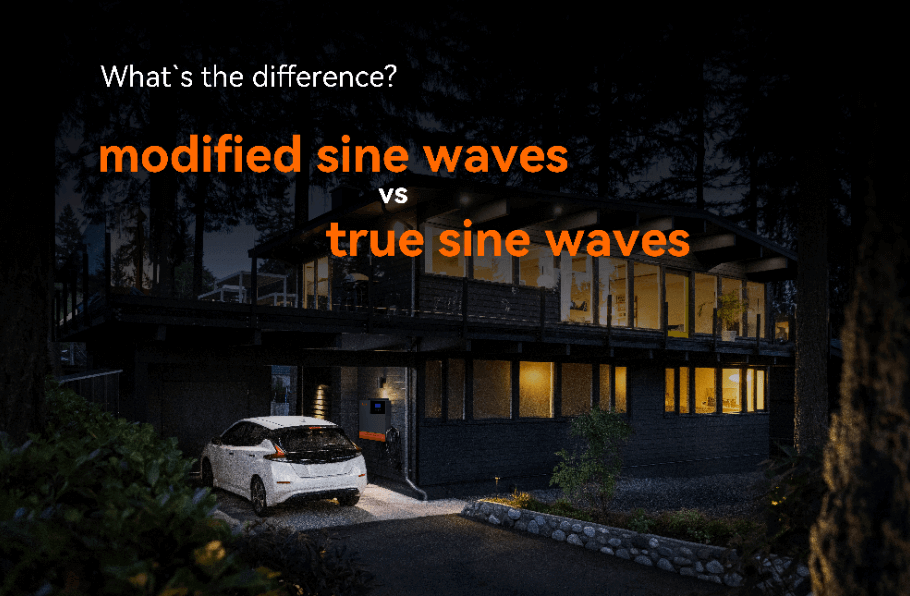Inverter is a device whose purpose is convert the current from direct current (DC) to alternating current (AC), which reaches 110 - 220 volts depending on the model of the inverter.
The difference between direct current and alternating current is that direct current emits a flow in only one direction, while in alternating current, this flow quickly changes direction. The frequency with which the flow of electrical current changes direction can be measured. In United State, for example, that frequency is 60Hz, which means the current changes direction 120 times per second.
Depending on the waveform of the output current, the inverters can be is generally divided into square wave inverter and sine wave inverter.The latter is more suitable for solar kits because they have enough power to withstand the most normal consumption.
The working of sine wave inverter
The sine wave inverter works by controlling the switching on and off of semiconductor switching devices to output a series of pulses of equal amplitude and unequal width.
For solar sector, sine wave inverter is applied to convert current direct from solar photovoltaic panels or accumulators into alternating current with a sine wave type flow.
What is a pure sine wave inverter?
This type of inverters generates frequencies and voltages with great precision and accuracy.It produces a purer waveform than the mains itself, thus pure sine wave inverter not only is suitable for any electrical appliance that works on alternating current but also meets the need of most of advanced electronics such as microprocessors.
What is a modified sine wave inverter?
Modified sine wave is derived from the square wave in an attempt to be as resemble as possible to a pure sine wave, but not quite so. The current will not have the same characteristics and advantages as a pure sine wave. Even so, modified sine wave inverter
Modified sine wave vs pure sine wave inverter, which is better?
Cost
Pure sine wave inverters can provide high quality AC power, which is suitable for most of the electrical equipment and works stably, but they are more expensive.
Efficiency
The modified sine wave inverter, which has a time interval between the positive maximum and the negative maximum of the output waveform, is improved in use, but the modified sine wave essentially consists of dashes,so this inverter has poor continuity and is not as efficient as a pure sine wave inverter.
Interference
The modified sine wave inverter meets the needs of most electrical equipment, but it still has a 20% harmonic distortion which can cause problems when running precise equipment and can also cause high frequency interference to communications equipment.
Buyer's guide to solar inverter: modified sine wave vs. pure sine wave inverter
Who need a modified sine wave
Modified wave inverters are for devices that do not have a motor and do not work well with complex appliances. Of course, if you need an affordable power conversion product, a modified wave inverter is also sufficient for your daily life.
Who need a pure sine wave inverter
The pure sine wave has a higher load carrying capacity than the modified sine wave. Pure sine wave inverters generate the same wave that we have in our home and work with all kinds of devices or sensitive electronics.
In other words, the device can carry inductive loads and any other type of general AC load, such as refrigerators, televisions and radios, without interference or noise, and without affecting the performance and lifespan of the load equipment.
Conclusion
The pure sine wave inverter is of good quality and high performance, which simply means that the output is stable and better protects your mobile devices such as smartphones, cameras, game consoles, tablets, car fridges, LED fill lights and so on.
Last but not least, we recommend the pure sine wave inverters from Powmr, which has comprehensive protection functions for over-voltage, under-voltage, overload, overheating, short-circuit and reverse connection, thus ensuring the stability and safety of the system.
Note:
When choosing an inverter, must be sure that its starting power is higher than the appliance to be used. Because the inverter itself consumes part of the power when working, its input power is greater than its output power. For example, if an inverter inputs 100 watts of DC and outputs 85 watts of alternating current, its efficiency is 85%.



